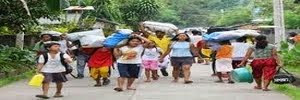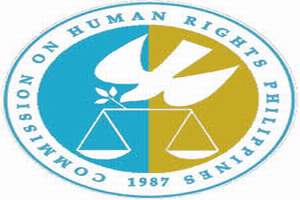
From the Website of DSWD
links: http://www.dswd.gov.ph/2014/11/yolanda-made-samar-community-stronger-wiser-through-dswd-program/
World Bank official cites need for community-driven development in urban poor areas
“CDD is needed in urban areas.”
This was the statement by Maria Loreto Padua, the Social Development Specialist of World Bank, referring to the community-driven development (CDD) strategy following the presentation of Mr. Jojo Aguilar, Deputy National Program Manager for Operations of Kapit-Bisig Laban sa Kahirapan Comprehensive and Integrated Delivery of Social Services-National Community-Driven Development Program (KALAHI CIDSS-NCDDP), on the lessons learned by the Department of Social Welfare and Development (DSWD) in piloting the strategy in urban areas.
The presentation was made as part of the mission kick-off of the 2nd Implementation Support Mission of World Bank and the Asian Development Bank on KALAHI CIDSS-NCDDP, held on November 13 at the DSWD Central Office in Quezon City.
The KALAHI CIDSS-NCDDP urban CDD pilot and subsequent rollout had two modalities. One is through a US$3,000,000 grant from the Japan Social Development Fund-Livelihood Opportunities for Vulnerable Urban Communities (JSDF-LVUC). This is focused on providing income-generating activities and opportunities for urban poor communities. This covered 69 communities in Cavite, Laguna, and Metro Manila.
The other is implemented as part of the World Bank Additional Financing (KC-AF) loan to cover Kalahi-CIDSS, the predecessor of KALAHI CIDSS-NCDDP. Aside from seeking to address livelihood concerns, this was also intended to address issues that cause or worsen poverty in urban poor communities. This covered eight barangays in Legazpi City, Kabankalan, Cagayan de Oro City, and Butuan City.
Both are slated to end in this year.
Aguilar’s presentation focused on the lessons generated from these two urban CDD projects.
Key findings include differences between implementation in the rural and urban poor communities.
Prior to these projects, Kalahi-CIDSS operated exclusively in rural areas, which is why design changes needed to be made in the standard processes of the program in order to fit the needs of urban communities.
Padua, however, stated that while there were major differences between CDD implementation in urban and rural settings, the objective of KALAHI CIDSS-NCDDP remains the same.
She said, “The problem in rural and urban communities is still basically the same: access to basic services. CDD in KALAHI CIDSS-NCDDP continues to provide basic service delivery,” referring to how the program improves its covered communities’ access to basic social services, usually by way of building small-scale infrastructure facilities such as school buildings, health stations, access paths, and roads using the CDD strategy.
CDD puts power back in the hands of the people by giving them the opportunity to make informed decisions on locally identified options for development and manage resources to implement sub-projects that address needs identified by communities themselves.
In KALAHI CIDSS-NCDDP, volunteers are provided trainings throughout the process, which include but are not limited to project and funds management, procurement, and project implementation. They are then able to develop these chosen sub-projects through the provision of small community grants.
Padua said, “Communities can actually use the small funds from KALAHI CIDSS-NCDDP as leverage for bigger programs. It is not just the block grants that matter, but the process as well.”
She also asked DSWD on whether the Agency has plans on furthering urban CDD.
DSWD Assistant Secretary Camilo Gudmalin said that KALAHI CIDSS-NCDDP is looking into the next steps for this.
KALAHI CIDSS-NCDDP is the expansion into a national scale of operations of CDD approach, which was tried and proven effective by Kapit-Bisig Laban sa Kahirapan-Comprehensive and Integrated Delivery of Social Services (Kalahi-CIDSS). It targets the coverage of 847 of the poorest municipalities in the country.
For more information about KALAHI CIDSS-NCDDP, please visit http://ncddp.dswd.gov.ph.### - See more at: http://www.dswd.gov.ph/2014/11/world-bank-official-cites-need-for-community-driven-development-in-urban-poor-areas/#sthash.cirwoIQ5.dpuf
DSWD Website
http://www.dswd.gov.ph/
Article Links
http://www.dswd.gov.ph/2014/09/pantawid-pamilya-model-family-a-blessing-to-their-community/
OTHER HUMAN RIGHTS PROMOTIONS WEBSITES
Human Rights Advocacy Promotions | Human Rights
Home - Human rights Promotions Website
HUMAN RIGHTS PROMOTIONS
PROTECTION AND PROMOTION OF HUMAN RIGHTS
-----------------------------------------------------------------------------------------------
------------------------------------------------------------
-----------------------------
http://www.dswd.gov.ph/
Article Links
http://www.dswd.gov.ph/2014/09/pantawid-pamilya-model-family-a-blessing-to-their-community/
OTHER HUMAN RIGHTS PROMOTIONS WEBSITES
Human Rights Advocacy Promotions | Human Rights
Home - Human rights Promotions Website
HUMAN RIGHTS PROMOTIONS
PROTECTION AND PROMOTION OF HUMAN RIGHTS
-----------------------------------------------------------------------------------------------
------------------------------------------------------------
-----------------------------

























































0 comments:
Post a Comment